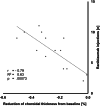Vanishing pachy-choroid in pachychoroid neovasculopathy under long-term anti-vascular endothelial growth factor therapy
- PMID: 34193089
- PMCID: PMC8243878
- DOI: 10.1186/s12886-021-02022-1
Vanishing pachy-choroid in pachychoroid neovasculopathy under long-term anti-vascular endothelial growth factor therapy
Abstract
Background: To investigate the diagnostic value of choroidal thickness in the definition of pachychoroid neovasculopathy (PNV), especially in eyes treated with anti-vascular endothelial growth factor (VEGF) therapy.
Methods: Twenty-two consecutive eyes of 11 patients with uni- or bilateral PNV were analyzed. Anti-VEGF treatment was correlated with changes in choroidal thickness on enhanced depth imaging optical coherence tomography.
Results: There were 14 eyes with PNV and 8 non-neovascular partner eyes. Mean age was 64.2 ± 4.0 (range: 60-72), total follow-up was 1.8 ± 0.4 (1-2) years. In PNV eyes, choroidal thickness at baseline was 400 ± 58 (269-485) μm. After two years and 13 anti-VEGF injections on average, a mean reduction of - 39 ± 10 (- 26 to - 56) % to final 241 ± 52 (162-327) μm was observed (p < 0.0001). Meanwhile, choroidal thickness in the partner eyes remained stable (p > 0.13 for all comparisons). A significant correlation of choroidal thinning and anti-VEGF injection rate was observed at year one (r = - 0.79; R2 = 0.63; p = 0.00073) and two (r = - 0.69; R2 = 0.48; p = 0.019). While 85.7% of PNV eyes exceeded a pachychoroid threshold of ≥350 μm at baseline, this figure dropped to 21.4% at year one and 0% at year two.
Conclusion: In PNV, choroidal thickness significantly decreases with anti-VEGF therapy, resembling a "vanishing pachy-choroid", and thus does not represent a valid long-term diagnostic criterium, especially when differentiating PNV from nAMD.
Keywords: Central serous chorioretinopathy; Choroidal neovascularization; Optical coherence tomography; Pachychoroid; Pachychoroid neovasculopathy; Ranibizumab; Vascular endothelial growth factor.
Conflict of interest statement
No author reports any financial interest relevant to this study.
Benedikt Schworm received previous speaker fees and travel expenses from Novartis Pharma GmbH and Topcon Corporation. Nikolaus Luft received income from honoraria as a lecturer from Alcon Laboratories Inc., NIDEK Co. Ltd. and CenterVue SpA. Leonie F Keidel received income from honoraria as a lecturer from Recordati Pharma GmbH. Thomas C Kreutzer received previous speaker fees from Alcon Pharma GmbH. Thomas C Kreutzer received personal consultation fees from Novartis Pharma GmbH and Bayer AG. Thomas C Kreutzer received travel reimbursement from D.O.R.C. (International) B.V. Karsten Kortuem received previous speaker fees and/or travel expenses from Novartis Pharma GmbH, Bayer AG, and Alcon Pharma GmbH. Karsten Kortüm received personal consultation fees from Big Picture Medical. Karsten Kortüm received travel expenses from Pharm-Allergan GmbH and Heidelberg Engineering GmbH. Armin Wolf received previous speaker fees and research funds from Novartis Pharma GmbH, Oertli AG, Bayer AG, Pharm-Allergan GmbH and Alimera Sciences Ophthalmologie GmbH. Tina Rike Herold received income from honoraria as a lecturer from Novartis GmbH, Bayer AG and Pharm-Allergan GmbH. Siegfried Priglinger received previous speaker fees and/or travel expenses from Novartis Pharma GmbH, Oertli AG, Bayer AG, Alcon Pharma GmbH and Pharm-Allergan GmbH. Jakob Siedlecki received previous speaker honoraria, personal consultation honoraria and travel expenses from Novartis Pharma GmbH, Bayer AG, Roche AG, Carl Zeiss Meditec AG, Oculentis OSD Medical GmbH and Allergan GmbH.
Figures



Similar articles
-
Changes in Choroidal Thickness After Intravitreal Injection of Anti-Vascular Endothelial Growth Factor in Pachychoroid Neovasculopathy.Invest Ophthalmol Vis Sci. 2018 Feb 1;59(2):1119-1124. doi: 10.1167/iovs.17-22144. Invest Ophthalmol Vis Sci. 2018. PMID: 29490349
-
Pachychoroid neovasculopathy: a type-1 choroidal neovascularization belonging to the pachychoroid spectrum-pathogenesis, imaging and available treatment options.Int Ophthalmol. 2020 Dec;40(12):3577-3589. doi: 10.1007/s10792-020-01522-1. Epub 2020 Jul 30. Int Ophthalmol. 2020. PMID: 32729062 Review.
-
Progression of Pachychoroid Neovasculopathy into Aneurysmal Type 1 Choroidal Neovascularization or Polypoidal Choroidal Vasculopathy.Ophthalmol Retina. 2022 Sep;6(9):807-813. doi: 10.1016/j.oret.2022.04.004. Epub 2022 Apr 7. Ophthalmol Retina. 2022. PMID: 35398547
-
Treatment outcomes of pachychoroid neovasculopathy with photodynamic therapy and anti-vascular endothelial growth factor.Indian J Ophthalmol. 2019 Oct;67(10):1678-1683. doi: 10.4103/ijo.IJO_1481_18. Indian J Ophthalmol. 2019. PMID: 31546507 Free PMC article.
-
Pachychoroid Spectrum Disorders: An Updated Review.J Ophthalmic Vis Res. 2023 Apr 19;18(2):212-229. doi: 10.18502/jovr.v18i2.13188. eCollection 2023 Apr-Jun. J Ophthalmic Vis Res. 2023. PMID: 37181617 Free PMC article. Review.
Cited by
-
Six-month outcomes of half-fluence photodynamic therapy combined with intravitreal Aflibercept injection for pachychoroid neovasculopathy.Graefes Arch Clin Exp Ophthalmol. 2025 Aug 25. doi: 10.1007/s00417-025-06945-z. Online ahead of print. Graefes Arch Clin Exp Ophthalmol. 2025. PMID: 40853386
-
Anatomical and Functional Outcomes of Anti-VEGF Therapy in Pachychoroid Neovasculopathy.Clin Ophthalmol. 2025 Aug 12;19:2699-2707. doi: 10.2147/OPTH.S529840. eCollection 2025. Clin Ophthalmol. 2025. PMID: 40823156 Free PMC article.
-
Wide-Field Choroidal Thickness Analysis after Half-Fluence Photodynamic Therapy Combined with Intravitreal Aflibercept Injection in Pachychoroid Neovasculopathy.J Clin Med. 2024 Mar 11;13(6):1608. doi: 10.3390/jcm13061608. J Clin Med. 2024. PMID: 38541834 Free PMC article.
-
Relationship between Pachychoroid and Polypoidal Choroidal Vasculopathy.J Clin Med. 2022 Aug 8;11(15):4614. doi: 10.3390/jcm11154614. J Clin Med. 2022. PMID: 35956229 Free PMC article. Review.
References
-
- Mrejen S, Balaratnasingam C, Kaden TR, Bottini A, Dansingani K, Bhavsar KV, Yannuzzi NA, Patel S, Chen KC, Yu S, Stoffels G, Spaide RF, Freund KB, Yannuzzi LA. Long-term visual outcomes and causes of vision loss in chronic central serous Chorioretinopathy. Ophthalmology. 2019;126(4):576–588. doi: 10.1016/j.ophtha.2018.12.048. - DOI - PubMed
-
- Bonini Filho MA, de Carlo TE, Ferrara D, Adhi M, Baumal CR, Witkin AJ, Reichel E, Duker JS, Waheed NK. Association of Choroidal Neovascularization and Central Serous Chorioretinopathy with Optical Coherence Tomography Angiography. JAMA Ophthalmol. 2015;133(8):899–906. doi: 10.1001/jamaophthalmol.2015.1320. - DOI - PMC - PubMed
-
- Hwang H, Kim JY, Kim KT, Chae JB, Kim DY. Flat irregular pigment epithelium detachment in central serous chorioretinopathy: a form of Pachychoroid Neovasculopathy? Retina. 2020;40(9):1724-33. 10.1097/IAE.0000000000002662. - PubMed
MeSH terms
Substances
LinkOut - more resources
Full Text Sources
Medical

